Laying water supply pipes in an apartment: common schemes and implementation options
Water is a key element of life support for every home.And proper layout of water supply pipes in the apartment allows you to ensure uninterrupted water supply to all water intake points - plumbing and equipment.
System design is based on hydraulic calculations, determination of probable pressure losses and selection of pipe diameters. The wiring diagram itself - collector or serial - will also play an important role. Agree, at first glance everything seems complicated and confusing. However, it is not.
We will help you understand the nuances of arranging the internal water supply network, and outline the principles and layout of the main line. After studying the material, you will be able to handle the design and installation of water supply pipes yourself.
The content of the article:
- Designing a water supply system in an apartment
- Hydraulic calculation of apartment water supply
- Calculation of the diameter of water pipes
- Calculation of water pressure losses
- Water supply wiring diagrams
- Pipes for residential water supply
- Connections of metal pipes with bends
- Nuances of assembling metal-plastic pipes
- Conclusions and useful video on the topic
Designing a water supply system in an apartment
Preparing the correct water supply layout project will allow you to avoid problems both at the stage of pipe installation and later, when using water-consuming equipment.
You should accurately determine the list of plumbing fixtures and stationary household equipment that consumes water, the installation of which will be carried out in the apartment. Then draw a plan of the apartment to scale, mark on it the positions of devices that require connection to the water supply.
It remains to determine the pipeline decoupling scheme, which takes into account all water-consuming stationary equipment in the plan.In addition to water consumers, the diagram indicates equipment that is part of the water supply system (water meters, pumps, etc.), length of pipeline sections and pipe diameters.
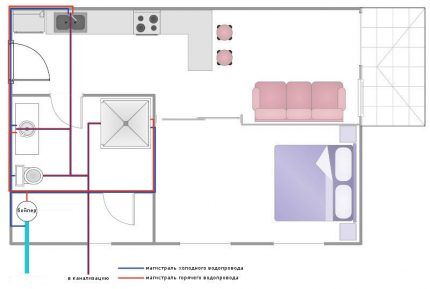
Ideally, the diagram should take into account the positions and characteristics (size, type) of adapters, fittings, couplings, etc. However, this is only feasible for a plumber. It’s easier to prepare a project without these “details”, go with it to a plumbing store and show the project to the seller. He will help you select the necessary “small” components.
But before you go for pipes and fittings, you need to make a hydraulic calculation of the water supply system project. This will make sure that there is no significant drop in pressure in the designed water distribution system and its ability to provide water to all consumers when they operate simultaneously.
Hydraulic calculation of apartment water supply
Hydraulic calculation of a water pipeline means the calculation of three parameters:
- water consumption in certain sections of the pipeline;
- water speed in the pipeline;
- pipe diameter, at which the pressure drop will be acceptable.
If, taking into account the losses due to movement through the pipeline, the pressure is below normal, it will be necessary to install an incentive pump on the water supply.
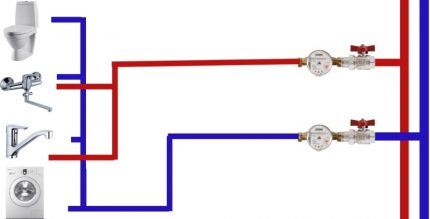
You can establish the standard water consumption for certain plumbing equipment either from its technical passport, or, in a generalized format, according to SP 30.13330.2012 (Appendix A1).
Information on standard consumption from the named application, applicable to household plumbing, is indicated in the table in the picture.
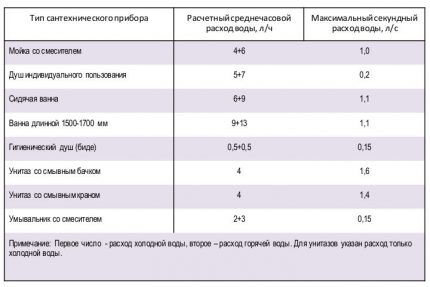
there is a high risk of insufficient pressure. This is especially true for serial pipelines (+)
Since the plumbing fixtures in the apartment are part of the same water supply network and their simultaneous use is expected, the costs for them are summed up.
For example, the residential water supply network includes a washbasin, shower and toilet, the simultaneous operation of which is quite possible. Let's sum up the highest second flow rates of the first two devices: 0.15+0.2=0.35 l/s.
For the toilet, the table shows the maximum water flow per second for flushing, not for filling the tank. Therefore, it is necessary to recalculate the average hourly flow rate for this plumbing fixture in seconds: 4:3600 = 0.0011 l/s. The total second consumption for three devices will be: 0.35+0.0011= 0.3511 l/s.
Calculation of the diameter of water pipes
The cross-section of a water pipe, or more precisely the cross-sectional area, is determined by the formula:
S=π·r2,
Where:
- S – pipe cross-sectional area, m2;
- π – the number “pi” with a sufficient value of 3.14;
- r – radius of the internal section, m.
As a rule, in relation to steel pipes, the radius value is equal to half the value of their nominal bore (DN). For plastic pipes, the nominal outside diameter and inside diameter usually differ by one step.For example, a 40 mm polypropylene pipe has an internal diameter of approximately 32 mm.
Using only the formula for calculating the cross-sectional area of pipes, it will not be possible to calculate the necessary throughput parameters of the water supply system.
You need to use one more formula:
Q=V·S,
Where:
- Q – water consumption, m3;
- V – water flow speed, m/s;
- S – pipe cross-sectional area, m2.
Standards for internal water supply systems limit the range of water speed to 0.7-1.5 m/s. If the water moves at a higher speed, then the water pipes make quite a loud noise. Let us determine the internal cross-section of the pipeline, taking into account the highest permissible water speed.
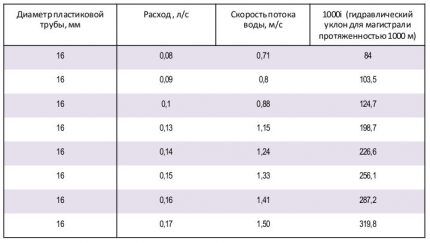
if the pressure drops in a 16 mm pipeline due to insufficient cross-section, the booster pump will not help (+)
First, let’s convert the estimated water consumption, using the data calculated above for the washbasin, toilet and shower, into cubic meters per second: 0.3511·0.001= 0.0003511 m3/With.
Now you can calculate the minimum cross-sectional area of the pipeline by applying the second formula and entering the maximum permissible value of water speed: S = 0.0003511: 1.5 = 0.000234 m2.
Let's determine the radius of the internal section of the water pipeline using the first formula: r2=0.000234:3.14=0.00007452. We calculate the root of the obtained value and get: r = 0.00863 m. Accordingly, in millimeters, the radius of the internal section will be 8.63 mm.
By multiplying the resulting radius value by two, we find the required pipe diameter for the water supply: 8.63 2 = 17.26 mm. Those. the optimal pipeline diameter will be 20 mm (rounded up).
Calculation of water pressure losses
The formula for determining the pressure loss on a pipeline of a certain length is as follows:
H=iL·(1+K),
Where:
- H – value of pressure loss, m;
- i – hydraulic slope of the pipes of the apartment’s water supply network;
- L – length of water supply pipes, m;
- K – coefficient associated with the purpose of the water supply network.
For pipelines carrying water for domestic and drinking purposes, the coefficient K is 0.3.
In general, the greatest difficulty with this formula arises in relation to the little understood parameter “hydraulic slope”. It refers to the resistance to water movement provided by the pipe.
Parameters affecting hydraulic slope:
- Water speed. Higher speed means higher hydraulic resistance of the pipeline.
- Diameter of water-carrying pipe. The smaller it is, the higher the value of hydraulic resistance.
- The degree of smoothness of the inner walls of the pipe. This characteristic depends on the material of the pipeline (a HDPE pipe is smoother than a steel pipe) and its service life (lime deposits, rust).
The most convenient way to calculate the hydraulic slope is the F.A. table. Sheveleva. Using it, you can relatively quickly determine the hydraulic slope, taking into account the diameter, material of the pipeline and water speed.

you will need to either build a line on the collector comb, or use a 20 mm pipe (+)
However, the information from Shevelev’s table is somewhat outdated - modern plumbing works under higher excess pressure than plumbing fixtures of the last century. Today normal is excessive pressure in the apartment water supply must be at least 0.3 kgf/m.
Let us take as an example the loss of pressure in a water supply system made of a plastic pipe with a diameter of 20 mm, a total length of 23 m and a maximum water speed of 1.5 m/s.
The hydraulic slope for a pipeline with the above parameters will be 232.7, provided its length is 1000 m (1000i). To find the value of i used in the formula for calculating the pressure drop, you need to divide by 1000, i.e. 232.7:1000=0.2327.
Taking into account the coefficient value of 0.3 (water supply for domestic and drinking purposes), we calculate the formula: H=0.2327·23·(1+0.3)=6.95 m.
Those. an excess pressure at the last (end) plumbing fixture of 0.5 atmospheres will be achieved if a pressure of 0.5+0.695=1.195 kgf/cm is maintained in the apartment water supply network2.
Since the pressure in the main pipeline is usually not lower than 2.5 atmospheres, the operating conditions for the water supply system considered in the example are fully met.
Water supply wiring diagrams
The choice of the optimal connection scheme for water-consuming plumbing equipment depends on the number of consumers, the stage of renovation in which the apartment is located and the financial capabilities of its owner.
Today, the most common two methods of distributing water supply to residential consumers are:
- Sequential. A single main-type pipeline emerges from the water supply risers, alternately supplying plumbing fixtures and household appliances.
- Collector. Through a water distributor, called a “comb,” the liquid is supplied to consumers in the apartment through separate pipes.
Often, in residential water supply systems, both types of wiring are combined, this can be convenient and profitable.Let us consider these schemes in more detail.
Sequential plumbing
When planning to build an apartment water supply system using tees (sequential), it is important not to make a mistake with the diameter of the pipes. The correct choice of the cross-section of the main line will be made possible, among other things, by calculating the water pressure loss.
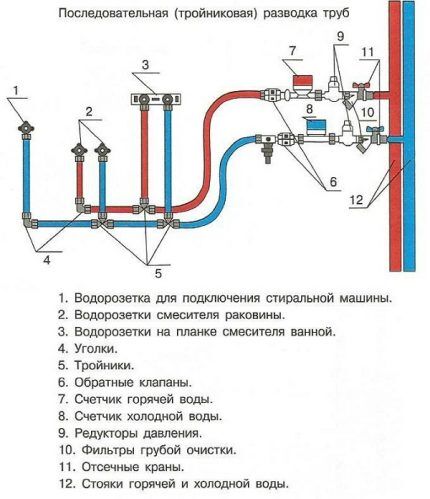
This method of constructing water supply in apartments was widely used in the Soviet past for the following reasons - small housing area, simplicity and low cost of work.
The disadvantages of a series line are expressed in a significant decrease in water pressure at the last plumbing equipment connected to it. In hot water supply systems, the water cools down significantly; you have to drain it and wait until the liquid of the required temperature reaches the consumer through the pipe.
However, with a short length of the water supply system, the choice of a tee supply circuit is justified by its comparative cheapness.
Collective water supply of the apartment
What distinguishes a collector main from a series pipeline is the permissibility of using pipes of a smaller cross-section without loss of pressure. The water supply system on the comb does not need an incentive pump.
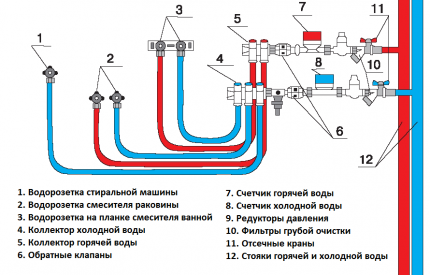
For large apartments, such a fan-shaped water distribution is ideal.
First of all, the volume of water supplied to each individual pipeline allows for precise adjustment. Special mechanisms on the collector “comb” are adjusted to supply the required volume of liquid.
This is especially convenient for DHW control - at any time you can reduce the supply of hot water to a certain point of consumption. But manifold plumbing circuits have complex architecture and require more pipes to build.
Pipes for residential water supply
Exactly water pipe material determines possible methods of their installation. There are four main types of pipes used in everyday life: steel, copper, metal-plastic and flexible pipes called plumbing pipes.
Steel pipes are the most durable and therefore reliable. Therefore, in apartments, all wiring associated with water risers is made only of steel. Galvanized steel has the greatest resistance to rust. steel pipes.
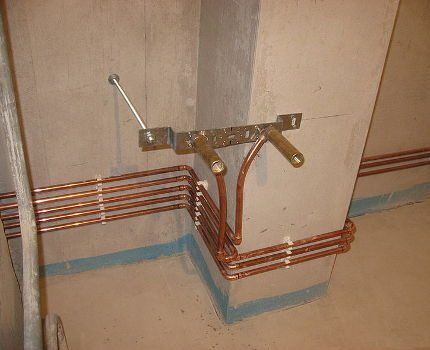
construction. Soldering segments of copper communications is not a task for an amateur
The assembly of the water supply system is carried out by welded and coupling connections, as well as using press fittings for steel pipes. Welding is not applicable for galvanized pipes, as it will destroy the protective layer.
Characterized by high reliability and durability copper pipes, but they are the most expensive. Copper pipes have high heat transfer; thermal insulation is required for them. The connection of copper pipes is carried out by capillary soldering and fittings - threaded and press fittings.
Despite all the convenience of plastic pipes as water supply lines, they have operational limitations - working with water at a temperature of less than 95 ° C and under a pressure of no higher than 10 atmospheres. The assembly of PVC segments when constructing a water supply network is carried out using special fittings.
Most common metal-plastic pipes. They are well suited for internal wiring in apartments. The main disadvantage of plumbing metal-plastic is its poor resistance to mechanical damage. Such pipes can only be installed embedded in walls; they cannot be laid out openly.
The flexible plumbing hose is enclosed in a metal coil. Thanks to the winding, it is able to withstand high pressure, but is not resistant to external damage.
This type of connection is used within the boundaries of any one room, for example, to connect a sink, dishwasher or washing machine, or water heater to a water source.
Connections of metal pipes with bends
Fixing pipe sections in this way is carried out on a threaded connection. The pipe sections to be connected must have female threads (one segment) and female threads (second segment). Threaded diameters are indicated in inches. Threads with diameters of 1/2, 3/4, one inch, one and a half, two inches, etc. are made.
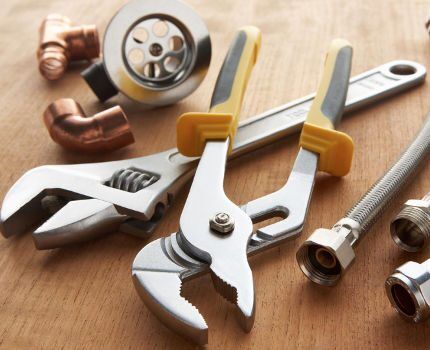
will allow you to tighten the nut and hold the pipe, and do this work with one hand
There are pipe and fastening threads. The first is cut on pipes, the second on couplings and other fasteners (fittings).
To connect two rigidly fixed sections of the pipeline, detachable connections are used - bends. A long thread is made on one pipe segment - sufficient to completely screw in the coupling and connect it to the second segment with a short thread cut.
All that remains is to screw the coupling from the bend of the first pipe onto the short thread of the second, connected to the first.
The procedure for assembling the drive is as follows:
- To seal a short thread, a linen winding is wrapped around it and coated with oil paint (for example, red lead). You can wind it with plastic fum tape.
- A lock nut is screwed onto the long threaded pipe section. It is necessary to fix the coupling.
- The coupling is screwed onto the long thread up to the locknut.
- Having aligned the pipes to be connected, screw the coupling onto the section with a short thread. All that remains is to seal the section of the long thread between the locknut and the coupling with a strand of flax, screw the locknut to the coupling so that the seal is in the chamfer of the locknut.
To form a surge, it is convenient to use special pipe wrenches - the Volevach and double-lever systems.

the distribution node will be the most reliable, its segments are guaranteed not to weaken
In addition to couplings, metal pipes can be connected with press fittings designed for copper or steel pipes. Press fittings are similar in appearance to conventional couplings, but have additional equipment - sealing rings. The latter are used for crimping pipes (special pliers are needed) connected by a press fitting.
Welded joints are the strongest, but only a specialist can perform them efficiently. Let us remind you that galvanized pipes cannot be welded, since the zinc layer will come off.
Capillary soldering, used when constructing a surge on a copper water supply, is performed with a burner that develops a temperature of 150OC. Solder melts in a 0.4 mm gap (no more!) between the fitting and the pipe, firmly connecting the segments of the water supply. Please note that such soldering can only be done by a professional; a non-specialist cannot do it.
The following photo selection will present methods for connecting copper pipes:
Nuances of assembling metal-plastic pipes
Installation is performed with a special tool: pipe cutters, calibrator, mandrels for bending pipes (internal and external), press tools and wrenches.
Metal-plastic pipes are usually connected using compression or press fittings. The principle of installing pipes through compression fittings is quite simple and is based on a threaded connection. Assembly using press fittings is more complicated, let's look at it in more detail.

The design of press fittings used in the assembly of metal-plastic communications includes an internal fitting and a compression sleeve. In the center of the press fitting there is a ring made of plastic-dielectric.
Before installation begins, the pipe is cut, and the cut location on it changes its shape to an oval shape. To return the end of a round metal-plastic pipe, a special tool is used - a calibrator.
Outwardly, it resembles a multi-tiered children's pyramid, only the rings are not removable. To align the cut end of the pipe to a certain radius, the calibrator is screwed into it using a handle.
To mount a compression fitting, you need to sequentially install a nut with a split ring on the pipe, carefully insert the fitting into the pipe until it stops, and then screw the nut.
To make a connection with a press fitting, a crimp ring is placed on the pipe, then a fitting is inserted and, using press jaws The sleeve is crimped.
The metal-plastic pipe is fastened to surfaces using special clips that are pre-fixed to the floor or walls.
Since metal-plastic pipes bend well, cutting them and installing a fitting in the bending area is not necessary. To give such a pipe a curved shape, internal or external flexible mandrels are used.
Conclusions and useful video on the topic
Assembly of a water supply system from metal-plastic pipes performed by a master plumber:
Practical video instructions for installing couplings for metal-plastic pipes, installing pipes and intermediate sections of water supply:
Video tutorial on capillary soldering of copper pipes for water mains:
Rules for choosing polypropylene pipes for water supply:
Building an efficient water supply system in an apartment is impossible without attention to detail at every stage - design, hydraulic calculations or assembly of the selected wiring diagram. However, it’s up to you to rely on standard solutions or build an effective water supply system for years to come.
Share with readers your personal experience in organizing the installation of water supply pipes. Please leave comments on the article, ask questions that interest you and participate in discussions about the material. The feedback block is below.



